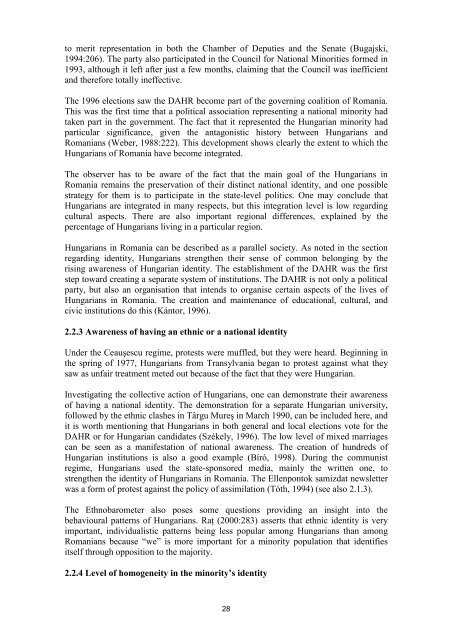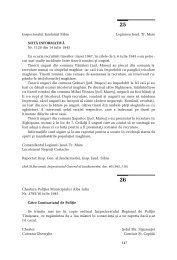Southeast Europe
Southeast Europe
Southeast Europe
You also want an ePaper? Increase the reach of your titles
YUMPU automatically turns print PDFs into web optimized ePapers that Google loves.
to merit representation in both the Chamber of Deputies and the Senate (Bugajski,<br />
1994:206). The party also participated in the Council for National Minorities formed in<br />
1993, although it left after just a few months, claiming that the Council was inefficient<br />
and therefore totally ineffective.<br />
The 1996 elections saw the DAHR become part of the governing coalition of Romania.<br />
This was the first time that a political association representing a national minority had<br />
taken part in the government. The fact that it represented the Hungarian minority had<br />
particular significance, given the antagonistic history between Hungarians and<br />
Romanians (Weber, 1988:222). This development shows clearly the extent to which the<br />
Hungarians of Romania have become integrated.<br />
The observer has to be aware of the fact that the main goal of the Hungarians in<br />
Romania remains the preservation of their distinct national identity, and one possible<br />
strategy for them is to participate in the state-level politics. One may conclude that<br />
Hungarians are integrated in many respects, but this integration level is low regarding<br />
cultural aspects. There are also important regional differences, explained by the<br />
percentage of Hungarians living in a particular region.<br />
Hungarians in Romania can be described as a parallel society. As noted in the section<br />
regarding identity, Hungarians strengthen their sense of common belonging by the<br />
rising awareness of Hungarian identity. The establishment of the DAHR was the first<br />
step toward creating a separate system of institutions. The DAHR is not only a political<br />
party, but also an organisation that intends to organise certain aspects of the lives of<br />
Hungarians in Romania. The creation and maintenance of educational, cultural, and<br />
civic institutions do this (Kántor, 1996).<br />
2.2.3 Awareness of having an ethnic or a national identity<br />
Under the Ceauşescu regime, protests were muffled, but they were heard. Beginning in<br />
the spring of 1977, Hungarians from Transylvania began to protest against what they<br />
saw as unfair treatment meted out because of the fact that they were Hungarian.<br />
Investigating the collective action of Hungarians, one can demonstrate their awareness<br />
of having a national identity. The demonstration for a separate Hungarian university,<br />
followed by the ethnic clashes in Târgu Mureş in March 1990, can be included here, and<br />
it is worth mentioning that Hungarians in both general and local elections vote for the<br />
DAHR or for Hungarian candidates (Székely, 1996). The low level of mixed marriages<br />
can be seen as a manifestation of national awareness. The creation of hundreds of<br />
Hungarian institutions is also a good example (Bíró, 1998). During the communist<br />
regime, Hungarians used the state-sponsored media, mainly the written one, to<br />
strengthen the identity of Hungarians in Romania. The Ellenpontok samizdat newsletter<br />
was a form of protest against the policy of assimilation (Tóth, 1994) (see also 2.1.3).<br />
The Ethnobarometer also poses some questions providing an insight into the<br />
behavioural patterns of Hungarians. Raţ (2000:283) asserts that ethnic identity is very<br />
important, individualistic patterns being less popular among Hungarians than among<br />
Romanians because “we” is more important for a minority population that identifies<br />
itself through opposition to the majority.<br />
2.2.4 Level of homogeneity in the minority’s identity<br />
28









